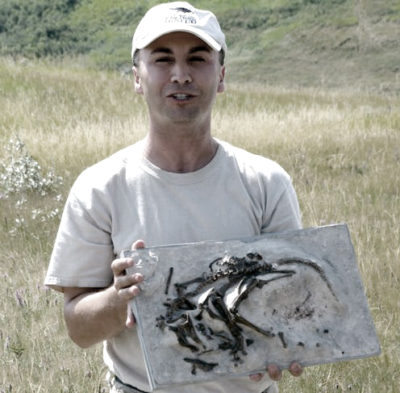 As the novelty generating the flight of birds, the feather, the most complex integumentary structure found in vertebrates, has long intrigued and fascinated naturalists.
As the novelty generating the flight of birds, the feather, the most complex integumentary structure found in vertebrates, has long intrigued and fascinated naturalists.
Since Charles Darwin published The Origin of Species in 1859, however, the origin of the feather emerged as a contentious issue. The newfound association between feathers and dinosaurs has only intensified the problem.
The first North American dinosaur reported with feathers appeared in the October 26th edition of Science. The research team, led by paleontologists Darla Zelenitsky (pictured right) from the University of Calgary, described three dinosaurs found in Alberta, Canada: one juvenile and two adult skeletons of the genus Ornithomimus. To their surprise, feathers covered these dinosaurs.
While their first discovery was made in 1995, with further findings in 2008 and 2009, their report, entitled “Feathered Non-Avian Dinosaurs from North America Provide Insight into Wing Origins,” was finally published this year.  following ten years of research.
following ten years of research.
“This is a really exciting discovery as it represents the first feathered dinosaur specimens found in the Western Hemisphere,” explained Zelenitsky. Importantly, explained in the ScienceDaily interview, Zelenitsky noted –
“Furthermore, despite the many ornithomimid skeletons known, these specimens are also the first to reveal that ornithomimids were covered in feathers, like several other groups of theropod dinosaurs.”
Othniel Charles Marsh discovered the first Ornithomimus in 1890 in the Colorado Denver Formation without any feathers noted. More recently, using the popular information at the time, the Ornithomimus, at roughly 11 feet long and 350 pounds, reached stardom in the Hollywood science fiction Jurassic Park movie.
 Chased by a ferocious Tyrannosaurus rex running at 30 miles an hour, Steven Spielberg portrayed the Ornithomimus as a herd of scaly-footed animals – just as Darwin had described reptiles in The Origin of Species –
Chased by a ferocious Tyrannosaurus rex running at 30 miles an hour, Steven Spielberg portrayed the Ornithomimus as a herd of scaly-footed animals – just as Darwin had described reptiles in The Origin of Species –
“Hair has been transmitted to almost all mammals, feathers to all birds, and scales to all true reptiles.”
Throughout the twentieth century, scales were a defining characteristic of reptiles, certainly, not feathers. Accepting Darwin’s classification system, not even paleontologists at the time were aware that feathers once covered dinosaurs. Zelenitsky explained to ScienceDaily, however, the distinctive age-related characteristics of these feathers –
“This dinosaur was covered in down-like feathers throughout life, but only older individuals developed larger feathers on the arms, forming winglike structures.”
“This pattern differs from that seen in birds,” Zelenitsky explained further, “where the wings generally develop very young, soon after hatching.”
Tree-Down Theory
During the twentieth century, several explanations for the origin of feathers gained popularity. Danish evolutionary zoologist Gerhard Heilmann (pictured right), in his book The Origin of Birds (1926), proposed the tree-down theory.  According to Heilmann, feathers originated –
According to Heilmann, feathers originated –
“By the friction of the air, the outer edges became frayed, the fraying gradually changing into still longer horny processes which in the course of time became more and more feather-like.”
Heilmann’s theory for the origin of the feather was known as the ‘tree-down” or the “arboreal theory.”
Ground-Up Theory
 Yale paleontologist John Ostrom (pictured left), however, undermined Heilmann’s “arboreal theory.” In the article Bird Flight, How Did It Begin (1979) published in the American Scientist, Ostrum points out –
Yale paleontologist John Ostrom (pictured left), however, undermined Heilmann’s “arboreal theory.” In the article Bird Flight, How Did It Begin (1979) published in the American Scientist, Ostrum points out –
“The animal had to be able to climb. However… that may not have been part of the repertoire of primitive birds, or even bird ancestors.”
Ostrom’s theory was previously proposed by Thomas Huxley, popularly known as “Darwin’s bulldog,” in the 1860s. Ostrom re-advocated the “from the ground up” or the “cursorial theory.” Ostrom reasoned –
“It is possible that the initial (pre-Archaeopteryx) enlargement of the feathers on its hand might have been to increase the hand surface area, thereby making it more effective in catching insects?… It is not difficult to visualize how advantageous these paired ‘insect nets would be in the snaring of lapping insects, or even in batting down escaping flying insects.”
Of these two once-popular theories, the tree-down or the ground-up, neither seems plausible for dinosaurs, especially since Zelenitsky’s team only found feathers capable of flying in the adults.
Mating Signals Theory
François Therrienn (pictured right), the curator at the Royal Tyrrell Museum and co-author of this new study, noted that the designed specialization of these age-related feathers might be for reproduction –
“The appearance of winglike structures [only] in older animals indicates that they may have evolved in association with reproductive behaviors…. The fact that winglike forelimbs developed in more mature individuals suggests they were used only later in life, perhaps associated with reproductive behaviors like display or egg brooding.”
As Zelenitsky explains further in an interview with the Smithsonian Institute –
“We infer that because these wing feathers are not showing up until later in life, they were used for reproductive purposes.”
As is ubiquitous in the evolution industry, the cause-and-effect explanations are frequently just “inferred,” not observed. Zelenitsky’s team, as did Charles Darwin, Thomas Huxley, Gerhard Heilmann, and John Ostrom, used deductive reasoning, not inductive reasoning.
Philosophy allows the deductive reasoning process. Science, however, excludes deductive reasoning and requires the exclusive use of inductive reasoning to ensure the elimination of any element of bias.
In the absence of validated scientific evidence, a natural explanation for the origin of the feather in the dinosaur, therefore, is philosophical, not scientific. Evolution paleontologist Stephen J Gould lamented this ubiquitous and systematic problem within the evolution industry –
“We fancy ourselves as the only true students of life’s history, yet to preserve our favored account of evolution by natural selection, we view our data as so bad that we rarely see the very process we profess to study.”
Genesis
The origin of the feather, the most complex integumentary structure found in vertebrates, is a premier example of a complex novelty and has no natural explanation. While Darwin’s dilemma intensifies, the feather, however, is compatible with the Genesis account written by Moses.
Sir Isaac Newton (pictured left), an English mathematician, astronomer, and physicist, recognized as the world’s most influential scientist today, played a leading role in launching the scientific revolution, wrote –
“There is one God, the Father, ever-living, omnipresent, omniscient, almighty, the Maker of heaven and earth, the one Mediator between God and man, the man Christ Jesus.”
Evidence from the fields of anatomy and morphology underscores why the theory of evolution remains speculative but not scientifically valid.
Origin of the Feather is an Anatomy and Morphology article.
Darwin Then and Now is an educational resource on the intersection of evolution and science, highlighting the ongoing challenges to the theory of evolution.
Move On
Explore how to understand twenty-first-century concepts of evolution further using the following links –
-
- The Understanding Evolution category showcases how varying historical study approaches to evolution have led to varying conclusions. Subcategories include –
- Studying Evolution explains how key evolution terms and concepts have changed since the 1958 publication of The Origin of Species.
- What is Science explains Charles Darwin’s approach to science and how modern science approaches can be applied for different investigative purposes.
- Evolution and Science feature study articles on how scientific evidence influences the current understanding of evolution.
- Theory and Consensus feature articles on the historical timelines of the theory and Natural Selection.
- The Biography of Charles Darwin category showcases relevant aspects of his life.
- The Glossary defines terms used in studying the theory of biological evolution.
- The Understanding Evolution category showcases how varying historical study approaches to evolution have led to varying conclusions. Subcategories include –
2020 Update
The Early Origin of Feathers, Michael J. Benton, Danielle Dhouailly, Baoyu Jiang, Maria McNamara
Trends in Ecology & Evolution, Volume 34, Issue 9, September 2019, Pages 856-869, said –
“Gene regulatory networks show the deep homology of scales, feathers, and hairs.”
“There are close connections in terms of genomic regulation between numerous regularly arrayed structures in the epidermis, including denticles in sharks, dermal scales in teleost fish, epidermal scales in reptiles, feathers in birds, and hairs in mammals.”
“These findings shift the origin of feathers back 80 million years (sic) before the origin of birds. Gene regulatory networks show the deep homology of scales, feathers, and hairs.”
The new evidence updates the theory; however, the origin of the feather remains a scientific mystery, undermining the evolutionary timetable.
Biological evolution is a philosophy, not a valid scientific theory.


